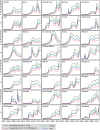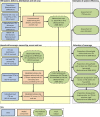Coverage and system efficiencies of insecticide-treated nets in Africa from 2000 to 2017
- PMID: 26714109
- PMCID: PMC4758960
- DOI: 10.7554/eLife.09672
Coverage and system efficiencies of insecticide-treated nets in Africa from 2000 to 2017
Abstract
Insecticide-treated nets (ITNs) for malaria control are widespread but coverage remains inadequate. We developed a Bayesian model using data from 102 national surveys, triangulated against delivery data and distribution reports, to generate year-by-year estimates of four ITN coverage indicators. We explored the impact of two potential 'inefficiencies': uneven net distribution among households and rapid rates of net loss from households. We estimated that, in 2013, 21% (17%-26%) of ITNs were over-allocated and this has worsened over time as overall net provision has increased. We estimated that rates of ITN loss from households are more rapid than previously thought, with 50% lost after 23 (20-28) months. We predict that the current estimate of 920 million additional ITNs required to achieve universal coverage would in reality yield a lower level of coverage (77% population access). By improving efficiency, however, the 920 million ITNs could yield population access as high as 95%.
Keywords: Bayesian compatment model; ITN; LLIN; Malaria; epidemiology; global health; human.
Conflict of interest statement
SIH: Reviewing editor,
The other authors declare that no competing interests exist.
Figures

















References
-
- AMP net mapping project, working group of the alliance for malaria prevention. http://allianceformalariaprevention.com/working-groups/net-mapping-project/ 2014
-
- Eisele TP, Keating J, Littrell M, Larsen D, Macintyre K. Assessment of insecticide-treated bednet use among children and pregnant women across 15 countries using standardized national surveys. The American Journal of Tropical Medicine and Hygiene. 2009;80:209–214. - PubMed

